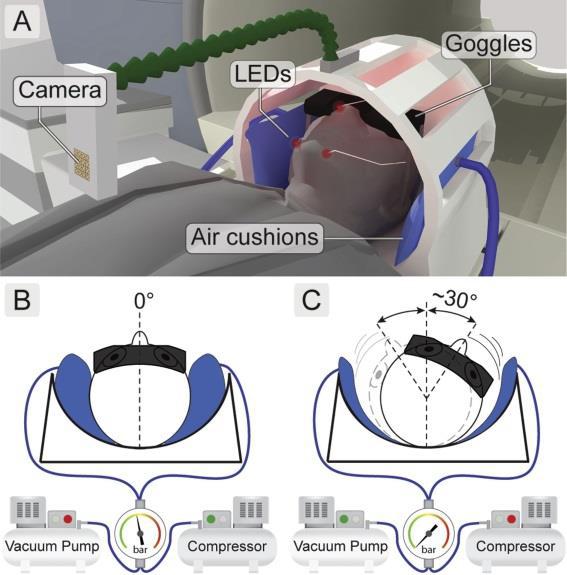Press Releases Archive
09.03.2018
Why the World Looks Stable While We Move
Tübingen Neuroscientists investigate the interaction of visual perception and head movements with functional magnetic resonance imaging
Every head movement changes the image of our environment that enters our eyes. We still perceive the world as stable, because our brain corrects for any changes in its visual information due to those head movements. For the first time worldwide, two neuroscientists of the University of Tübingen’s Werner Reichardt Centre for Integrative Neuroscience (CIN) have managed the difficult feat of observing these correction processes in the brain with functional magnetic resonance imaging (fMRI). Their study, now published in NeuroImage, carries far-reaching implications for our understanding of the effects of virtual realities on our brain.
Even while we move through it, our environment looks stable to us, because the brain constantly balances input from different senses. Visual stimuli are compared with, and corrected for input from our sense of equilibrium, of the relative positions of our head and body, and of the movements we are performing. The result: when we walk or run around, our perception of the world surrounding us does not roll our bounce. But when visual stimuli and our perception of movement do not fit together, this balancing act in the brain falls apart.
Anybody who has ever delved into fantasy worlds with virtual reality glasses may have experienced this disconnect. VR glasses continually monitor head movements, and the computer adapts the devices’ visual input. Nevertheless, prolonged use of VR glasses often leads to motion sickness: even modern VR systems lack the precision necessary for visual information and head movements to chime perfectly.
Up to now, neuroscientists have not been able to identify the mechanisms that enable the brain to harmonise visual and motion perception. Modern noninvasive studies on human subjects such as by functional magnetic resonance imaging (fMRI) run into one particular problem: images can only be obtained of the resting head.
Two Tübingen neuroscientists, Andreas Schindler and Andreas Bartels, have developed a sophisticated apparatus to circumvent this problem. They are now able to employ fMRI to observe what happens in the brain when we move our head while perceiving fitting – or non-fitting – visual and motion stimuli. In order to do so, subjects wearing VR glasses entered a specially modified fMRI scanner. In this scanner, computer-controlled air cushions quickly fixated the probands’ heads immediately following movement. During the head movements, the VR glasses displayed images that were were congruent with the movements. In other cases, the glasses displayed images incongruent with head movements. Right when the air cushions had stabilised the probands’ heads after the movements, the fMRI signal was recorded.
Andreas Schindler explains the procedure: “With fMRI, we cannot directly measure neuronal activity. fMRI just shows blood flow and oxygen saturation in the brain, with a delay of several seconds. That is often seen as a deficiency, but for our study, it was actually useful for once: we were able to record the very moment when the subject’s brain was busy balancing its own head movement and the images displayed on the VR glasses. And we were able to do so seconds after the fact, when the subject’s head was already resting quietly on its air cushion. Normally, head movements and brain imaging don’t go together, but we hacked the system, so to speak.”
In this way, the researchers could observe in the healthy human brain that which had so far only been investigated in primates and, indirectly, in certain patients with brain lesions. Their result: one area in the posterior insular cortex showed heightened activity whenever the VR display and head movements congruently simulated a stable environment. When the two signals conflicted, this heightened activity vanished. The same observation held true in a number of other brain regions reponsible for the processing of visual information in motion.
The new method and results open the door for a more focused study of the neuronal interactions between motion and visual perception. Moreover, the Tübingen researchers have shown for the first time what happens in the brain when we enter virtual worlds and balance on the knife’s edge between immersion and motion sickness.
Publication:
Andreas Schindler, Andreas Bartels: Integration of Visual and Non-Visual Self-Motion Cues during Voluntary Head Movements in the Human Brain. In: NeuroImage 172. S. 597–607. 15. Mai 2018 (online publication ahead of print).
doi: 10.1016/j.neuroimage.2018.02.006
Institutions Involved:
Werner Reichardt Centre for Integrative Neuroscience (CIN), Tübingen
Psychology Dept., Eberhard Karls University of Tübingen
Max Planck Institute for Biological Cybernetics, Tübingen
Author Contact Information:
Andreas Schindler
Werner Reichardt Centrum für Integrative Neurowissenschaften (CIN)
Otfried-Müller-Str. 25
72076 Tübingen
Tel.: +49 7071 29-89120
andreas.schindlerspam prevention@cin.uni-tuebingen.de
Andreas Bartels
Werner Reichardt Centrum für Integrative Neurowissenschaften (CIN)
Otfried-Müller-Str. 25
72076 Tübingen
Tel.: +49 7071 29-89168
andreas.bartelsspam prevention@cin.uni-tuebingen.de
Press Contact CIN:
Dr. Paul Töbelmann
Tübingen University
Wissenschaftskommunikation
Werner-Reichardt-Centrum für Integrative Neurowissenschaften (CIN)
Otfried-Müller-Str. 25 ∙ 72076 Tübingen
Telefon +49 7071 29-89108
paul.toebelmannspam prevention@cin.uni-tuebingen.de
www.cin.uni-tuebingen.de
Press Contact MPI:
Beate Fülle
MPI for Biological Cybernetics
Phone: +49 (0) 7071 601-777
Head of Communications and Public Relations
E-Mail: presse-kybspam prevention@tuebingen.mpg.de
Eberhard Karls Universität Tübingen
Public Relations Department
Dr. Karl Guido Rijkhoek
Director
Antje Karbe
Press Officer
Phone +49 7071 29-76789
Fax +49 7071 29-5566
antje.karbe[at]uni-tuebingen.de
https://www.uni-tuebingen.de/en/university/news-and-publications.html

